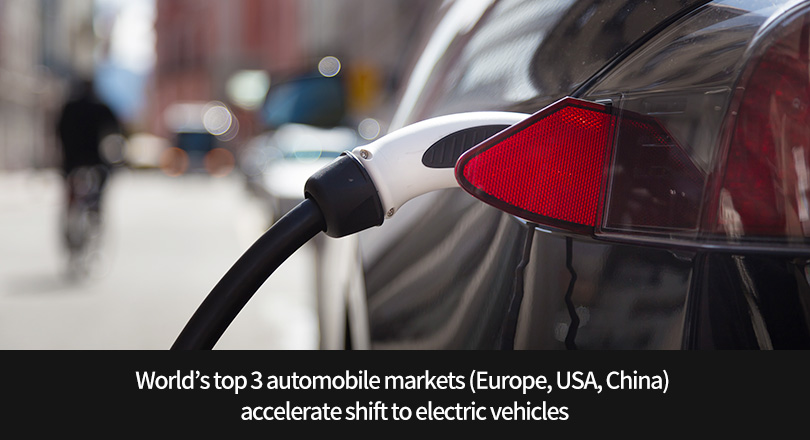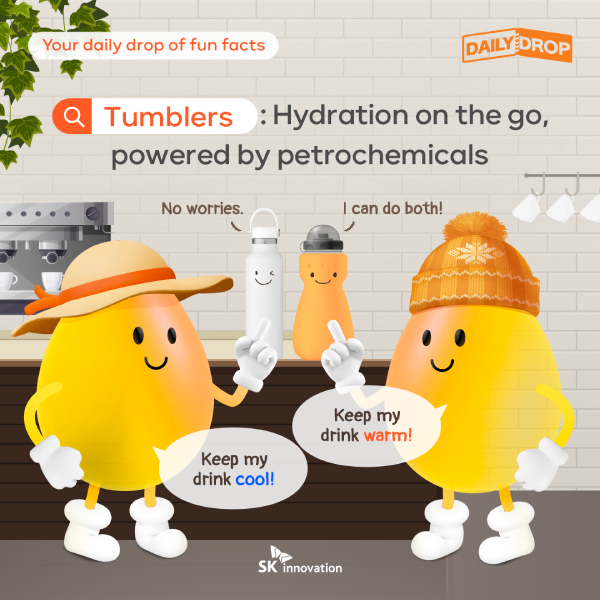 Trends & Reports
Trends & Reports
“The Stone Age did not end for lack of stone.”
– Ahmed Zaki Yamani, former Oil Minister of Saudi Arabia
The world’s automobile industry is accelerating the shift from internal combustion engines to electric vehicles (EV) due to enhanced international environmental policies introduced to reduce carbon footprints. Europe, USA and China, known as the top three automobile markets of the world, are fueling up the competition to take dominance, in line with the surging growth of the EV market.
| European carmakers saw a steep rise in the sales of EVs in the 2nd half of 2020
On January 30th, Financial Times reported that European carmakers vastly expanded their sales of EVs in response to the delays of EV production and launch amid the pandemic started in the first half of last year.” Another important reason that forced them to speed up that they would not want to be “fall foul of tough new emissions regulations and risk hundreds of millions of euros in fines.”
Financial Times’ report also cited that over 300,000 out of 730,000 western European EV manufactured in 2020 were delivered to customers in the last quarter of 2020, according to research by Bernstein.
Governments’ incentives plays a major role in boosting EV sales. In Germany, whose sales of electric vehicles tripled last year, has doubled subsidies for electric cars to 9,000 EUR per EV. Based on data collected by Auto Trader, the largest automotive marketplace in UK, the number of UK consumers searching online for an electric car doubled overnight after the government’s announcement of a phaseout of petrol sales by 2030.
In 2020, EV outstripped internal combustion engines including hybrid electric vehicles (HEV) in sales in Norway, which has been making every possible effort to reduce carbon footprints. On January 5 (local time), foreign news agencies including Reuters, Market Watch, etc. reported that, according to Norway’s Information Council for Road Traffic (OFV), EV accounted for 54.3% of new vehicles sold in 2020, making Norway the first country in the world that EV sales surpassed 50% market share.
| USA automobile industry accelerates transition to EVs backed by Biden administration’s green policies
President Biden’s eco-friendly policies and “Buy American” plan have strongly influenced the EV market in USA. Regarding the accelerating transition to EVs in line with the Biden administration’ push, Bloomberg has released various reports on January 29th and 30th and implied that USA is expecting to catch up with China and Europe soon in EV adoption rate. Accordingly, carmakers in the States are taking strong moves, such as General Motors (GM)’s pledge to to sell only EV in the U.S. from 2035.
Meanwhile, through invite-only social networking app Clubhouse, Tesla CEO Elon Musk highlighted stressed that “Tesla’s battery suppliers need to increase their production of battery cells,” according a report Bloomberg on February 1st. Tesla’s annual EV production target is around 20 million and this is 40 times the number of vehicles it delivered in 2020, which is approximately 500,000 vehicles. Once the target is reached, Tesla will have accounted for around 1% of 2 billion vehicles across the world by 2030.
Bloomberg also added that Panasonic is planning to ramp up its battery production capacity by investing approximately USD 100 on its Nevada-based Gigafactory 1 battery plant jointly run with Tesla. It is also known that Panasonic is seeking to build lithium-ion battery factories in Norway.
| China raises goals for EV proportion from 20% to 25% by 2025
Meanwhile, the Chinese government is strengthening its policies to nurture domestic EVs and EV battery companies. They raised the goal of EV proportion from 20% to 25% by 2025, and set up the goals of raising the proportion of fuel cell electric vehicles (HFCV) and plug-in hybrid electric vehicles (PHEV) to 50% by 2035, and ban gasoline and diesel engine vehicles. To this end, they decided to not only extend the subsidies upon purchase of an electric vehicle two years to 2022, but also introduced a waiver of the sales tax.
According to EVhui’s recent report on February 9th, in 2020 there are 471 models of new energy cars and they take up around 20% of the New Energy Vehicle Recommendation List 1 to 13 (hereinafter “Recommendation List”) released by China’s Ministry of Industry & Information Technology (MIIT) last year. There are 408 models for pure electric vehicle, 59 for PHEV, and 4 for fuel cell vehicle.
EVhui added, “In the 2020 recommendation list, batteries with top-5 energy densities were provided by SK Innovation which supplied batteries to BAIC’s premium EV brand ARCFOX, whereas in the list of 2019, it was CATL.”
According to a report on February 8th of Polaris Energy Storage Network (北极星储能网), Jiangsu Province government announced a “3-year action plan to enhance battery industrial chains” in December 2020, and pledged to establish 30 industrial chains for 3 years in Jiangsu, including the EV battery industry.”
Xing Chun Ning, the Associate Supervisor of the Standing Committee of the Jiangsu Provincial People’s Congress said “the EV battery industry isn’t the largest part of all 30 chains, but it is still important and its prospect is noteworthy.” Liyang and Jintan in Changzhou City are cited as the most active in investing EV battery industry in Jiangsu Province. There are more than 50 EV battery industry projects underway in Liyang, including CATL, Shanghai Automotive Industry Corp, etc. Meanwhile, SK Innovation, BAIC, and Beijing Electronics Holding’s JV battery factory BEST is located in Jintan, Changzhou.










 Youtube
Youtube Facebook
Facebook Instagram
Instagram Linkedin
Linkedin






















